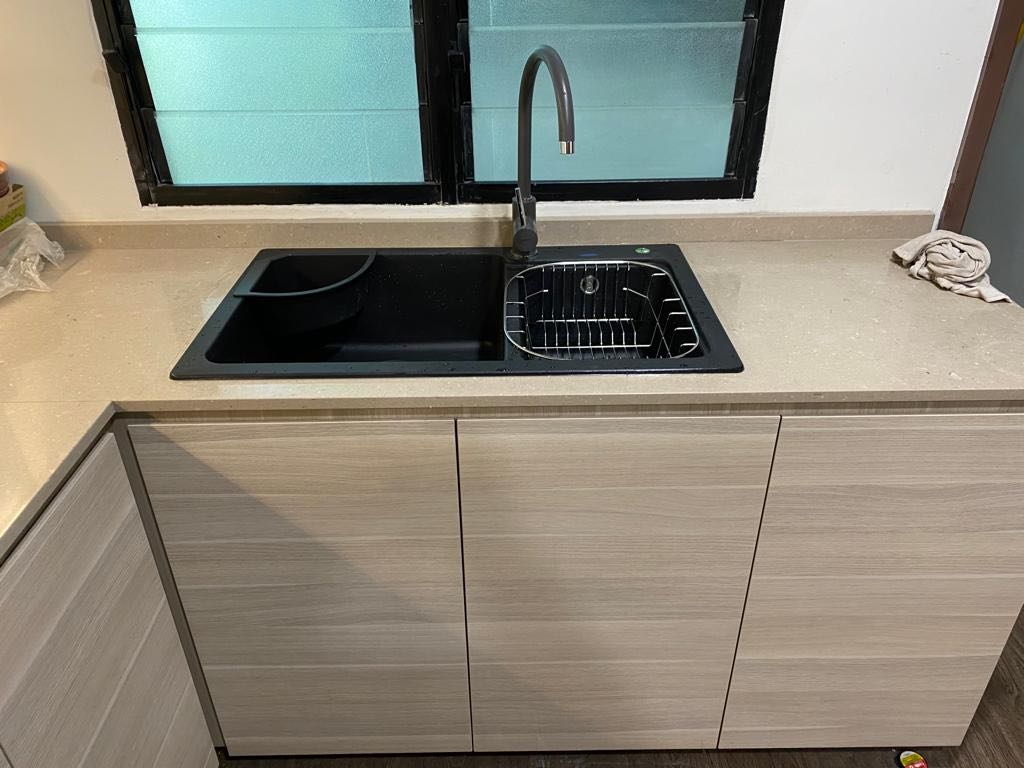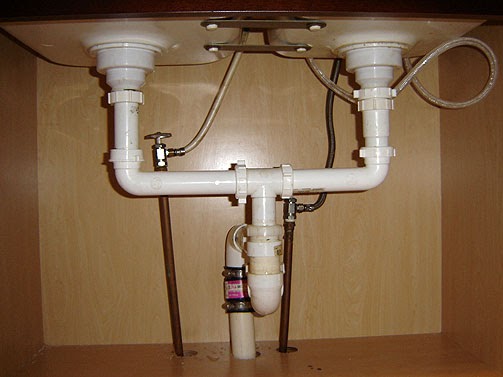Disconnecting the plumbing of your kitchen sink may seem like a daunting task, but with the right tools and knowledge, it can be done easily. Whether you are looking to replace your sink or do some plumbing repairs, disconnecting the kitchen sink plumbing is a necessary step. Before you disconnect the plumbing, make sure to turn off the water supply to your kitchen sink. You can do this by turning off the valves located under the sink or by shutting off the main water supply to your home. This will prevent any water from spilling out during the disconnection process. Next, you will need to remove any items from under the sink to give yourself room to work. This includes cleaning products, trash cans, and any other items that may be in the way. It is also a good idea to place a bucket or a towel under the pipes to catch any excess water that may drip out.Disconnecting Kitchen Sink Plumbing
If you are reinstalling your existing sink after making plumbing repairs, you will first need to remove the sink from its current position. This can be done by unscrewing any brackets or clips that are holding the sink in place. Once the sink is free, you can lift it out of the countertop. Before reinstalling the sink, it is important to clean the area thoroughly. Wipe down the countertop and remove any old caulk or debris that may have accumulated. This will ensure a clean and secure fit for your sink. Once the area is clean, you can place the sink back into position and secure it with new brackets or clips. Make sure the sink is level and then reattach the plumbing. Turn the water supply back on and test for any leaks.Reinstalling Existing Sink
If you are looking to completely remove your kitchen sink and replace it with a new one, you will need to remove the plumbing as well. Start by turning off the water supply and disconnecting the water lines from the faucet and the valves. Next, you will need to remove the drain pipes. This can be done by loosening the slip nuts that connect the pipes to the sink. You may need pliers to help loosen the nuts. Once the pipes are free, you can lift them out of the sink. After the plumbing is removed, you can then proceed to remove the sink from the countertop. This may require unscrewing any brackets or clips that are holding the sink in place. Once the sink is free, you can lift it out and dispose of it properly.Removing Kitchen Sink Plumbing
If you are looking to replace your kitchen sink plumbing, you will first need to purchase new pipes and fittings. Make sure to measure the old pipes before purchasing to ensure the new ones will fit properly. Start by connecting the new pipes to the sink. This can be done by tightening slip nuts with pliers. Next, attach the new water lines to the faucet and valves. Make sure to use Teflon tape to prevent any leaks. Once the new plumbing is in place, you can then proceed to reinstall the sink. Follow the steps mentioned earlier to secure the sink in place and reattach the plumbing. Turn the water supply back on and check for any leaks.Replacing Kitchen Sink Plumbing
If you are disconnecting and reinstalling your kitchen sink for any reason, make sure to follow the steps mentioned above. It is important to turn off the water supply and remove any items from under the sink before starting the process. If you are reinstalling the sink after making plumbing repairs, make sure to clean the area thoroughly before securing the sink in place. If you are reinstalling the sink in a different location, make sure to properly measure and secure the sink in its new location.Disconnecting and Reinstalling Kitchen Sink
If you are looking to remove and reinstall your kitchen sink in a different location, follow the steps mentioned earlier to remove the sink and plumbing. Once the sink is free, you can then proceed to reinstall it in its new location. Make sure to properly measure and secure the sink in its new location. You may also need to purchase new pipes and fittings to connect the sink to the existing plumbing. Turn the water supply back on and check for any leaks.Removing and Reinstalling Kitchen Sink
If you are looking to disconnect and replace your kitchen sink plumbing, make sure to turn off the water supply and remove any items from under the sink first. Follow the steps mentioned earlier to remove the old plumbing. Once the old plumbing is removed, you can then proceed to connect the new pipes and fittings. Make sure to properly secure them to prevent any leaks. Reinstall the sink and turn the water supply back on to test for any leaks.Disconnecting and Replacing Kitchen Sink Plumbing
If you are looking to remove and replace your kitchen sink plumbing, start by turning off the water supply and removing the old plumbing. Next, connect the new pipes and fittings and reinstall the sink. Make sure to properly secure the new plumbing and turn the water supply back on to test for any leaks. If you are not comfortable with plumbing work, it is always best to hire a professional to ensure the job is done correctly.Removing and Replacing Kitchen Sink Plumbing
If you are disconnecting and reinstalling your existing kitchen sink, make sure to follow the steps mentioned earlier. Turn off the water supply and remove any items from under the sink before starting the process. Once the sink is disconnected, you can then proceed to reinstall it in its original location. Make sure to properly secure the sink and reconnect the plumbing. Turn the water supply back on and check for any leaks.Disconnecting and Reinstalling Existing Sink
If you are looking to remove and reinstall your existing kitchen sink in a different location, follow the steps mentioned earlier to remove the sink and plumbing. Once the sink is free, you can then proceed to reinstall it in its new location. Make sure to properly measure and secure the sink in its new location. You may also need to purchase new pipes and fittings to connect the sink to the existing plumbing. Turn the water supply back on and check for any leaks. In conclusion, disconnecting and reinstalling kitchen sink plumbing may seem like a difficult task, but with the right tools and knowledge, it can be done easily. Make sure to turn off the water supply and remove any items from under the sink before starting the process. If you are not comfortable with plumbing work, it is best to hire a professional to ensure the job is done correctly.Removing and Reinstalling Existing Sink
Why disconnecting kitchen sink plumbing is an important step in house design

The importance of proper plumbing
The benefits of disconnecting kitchen sink plumbing
 When it comes to disconnecting kitchen sink plumbing, there are several benefits to consider. Firstly, it allows you to thoroughly clean and inspect the pipes and connections. This can help prevent clogs and identify any potential issues before they turn into costly repairs. Additionally, disconnecting the plumbing allows you to easily remove and replace the sink if needed, without causing damage to the pipes or surrounding fixtures.
When it comes to disconnecting kitchen sink plumbing, there are several benefits to consider. Firstly, it allows you to thoroughly clean and inspect the pipes and connections. This can help prevent clogs and identify any potential issues before they turn into costly repairs. Additionally, disconnecting the plumbing allows you to easily remove and replace the sink if needed, without causing damage to the pipes or surrounding fixtures.
How to disconnect and reinstall existing sink plumbing
 Disconnecting and reinstalling existing sink plumbing may seem like a daunting task, but it can easily be done with the right tools and knowledge. Before beginning, be sure to turn off the water supply to the sink and gather all necessary tools, such as a wrench and pliers. Start by disconnecting the water supply lines and then remove the sink from the countertop. From there, you can disconnect the drain pipes and replace any damaged parts. When reinstalling the sink, be sure to properly secure the connections and turn the water supply back on to test for any leaks.
Remember to always consult a professional
if you are unsure or uncomfortable with disconnecting and reinstalling your kitchen sink plumbing. They can provide guidance and ensure the job is done correctly, saving you time and potential headaches in the long run.
In conclusion, disconnecting kitchen sink plumbing is an essential step in house design. It not only helps maintain the functionality of your sink but can also prevent costly repairs and damage. By following proper steps and consulting a professional when needed, you can ensure your kitchen sink plumbing is in top shape for years to come.
Disconnecting and reinstalling existing sink plumbing may seem like a daunting task, but it can easily be done with the right tools and knowledge. Before beginning, be sure to turn off the water supply to the sink and gather all necessary tools, such as a wrench and pliers. Start by disconnecting the water supply lines and then remove the sink from the countertop. From there, you can disconnect the drain pipes and replace any damaged parts. When reinstalling the sink, be sure to properly secure the connections and turn the water supply back on to test for any leaks.
Remember to always consult a professional
if you are unsure or uncomfortable with disconnecting and reinstalling your kitchen sink plumbing. They can provide guidance and ensure the job is done correctly, saving you time and potential headaches in the long run.
In conclusion, disconnecting kitchen sink plumbing is an essential step in house design. It not only helps maintain the functionality of your sink but can also prevent costly repairs and damage. By following proper steps and consulting a professional when needed, you can ensure your kitchen sink plumbing is in top shape for years to come.



/how-to-install-a-sink-drain-2718789-hero-24e898006ed94c9593a2a268b57989a3.jpg)
















































































